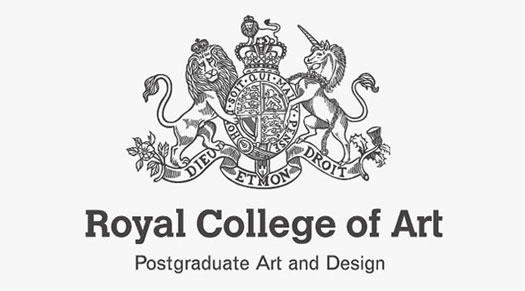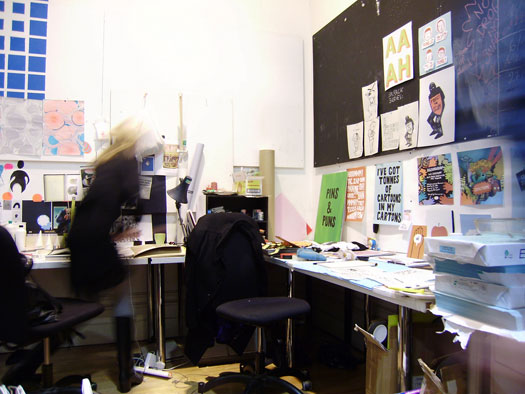
Most communication artists and designers would agree that it is our job to communicate. Where we disagree, sometimes intensely, is on how that is achieved. The fault lines of the debate are often drawn along the difference between "art" and "design" approaches, as in Michael Johnson's recent article on this week's selection process for a new Head of Department for the Communication Art & Design course at London's Royal College of Art. The RCA is the world’s only wholly-postgraduate school of art and design, and has produced a roster of well-known alumni including Alan Fletcher, Daniel Eatock, Jonathan Barnbrook, Why Not Associates, and Sara Fanelli.
In his article, Johnson argues that the current department, under the leadership of Dan Fern, has become hobbled by the "art" approach, and that its students are beholden to a working ethos that has little relevance for the outside world: "The key issue that has distracted the course for decades has been 'art'. Communications graduates have been at pains to present their work within the context of white walled galleries, not grubby old commerce. Work has often been presented as 'work in progress', never finished. The 'process' has become the king, not the problem to be solved."
For many, this is an inflammatory position. Is Johnson's problem-solving, commerce-oriented methodology the only legitimate approach? Or is it possible that the purpose of design education is to empower students to produce work that reflects their individual motivations, white-walled or not? Can't "art" and "design" approaches coexist simultaneously in our practice? Why are we so eager to create a cut-and-dry dichotomy between the two? As Adrian Shaughnessy remarked earlier this week in an article for Design Week, "Fern’s critics hope that his successor will push the course towards creating graduates with 'real world' skills in branding and digital communication. That’s the safe option. I'd prefer to see someone who could update Fern’s vision of a course which produces creative people capable of exploring new ways of thinking from a perspective of craft informed by artistic vision, for a world where commercial imperatives are no longer the only benchmarks for success."

Royal College of Art from Kensington Gardens
In my capacity as a researcher here at the college who has interacted extensively with students and tutors in the Communication Art & Design course, I would like to put forward some insights culled from observing the presentations from the short-listed candidates for Head of Department and the subsequent debate among students. The goal of this article is not to endorse any one particular candidate or approach, but to examine them in conversation with each other.
The short-listed candidates were invited to give 10-minute public presentations to students and staff, followed by interviews in front of a formal selection board that will render a final decision. Following the presentations, three candidates stood out as frontrunners among students: William Holder, Rick Poynor and Neville Brody. While it would be irresponsible to reduce any of the above to representing either an "art" or "design" perspective, students seemed to identify Holder with the availability of a workshop-like space where they would be exposed to multiple ways of thinking and making, and then pursue their practices on an individual basis; Poynor with connecting the course with the wider social and critical context in which it exists; and Brody with the need for the course to embrace a "revolution in communication" that would carry on with or without it.
In the student debate, Brody was considered the least ideal of the three because of what his critics perceived as a "narrow focus" regarding design in the context of future technologies. These students also argued that he seemed to exclude the "art" approach. The core of the debate centered around Poynor and Holder. Critics of Poynor felt the course would not change under his leadership because of his existing and extensive involvement at the RCA. More to the point, they argued that he did not successfully address the "art" component. In his presentation, he noted, "Artists can choose. They can communicate or not. Visual communicators are obligated to communicate something." Critics of Holder, on the other hand, argued that he represents an "art for art's sake" tack that does not pragmatically make a case for visual communication outside of the art and design world. While many of them acknowledged that Holder represents a valuable and necessary voice, they cautioned against an inward-facing approach that would be a detriment to the course in the contemporary milieu.
There's no question that the debate was heated and divisive. But the very process of an open and candid conversation gave students the opportunity to confront divergent views. It wasn't just a debate about the new head of department: it was a valuable means for understanding where they stood in relation to these critical issues.

In my capacity as a researcher here at the college who has interacted extensively with students and tutors in the Communication Art & Design course, I would like to put forward some insights culled from observing the presentations from the short-listed candidates for Head of Department and the subsequent debate among students. The goal of this article is not to endorse any one particular candidate or approach, but to examine them in conversation with each other.
The short-listed candidates were invited to give 10-minute public presentations to students and staff, followed by interviews in front of a formal selection board that will render a final decision. Following the presentations, three candidates stood out as frontrunners among students: William Holder, Rick Poynor and Neville Brody. While it would be irresponsible to reduce any of the above to representing either an "art" or "design" perspective, students seemed to identify Holder with the availability of a workshop-like space where they would be exposed to multiple ways of thinking and making, and then pursue their practices on an individual basis; Poynor with connecting the course with the wider social and critical context in which it exists; and Brody with the need for the course to embrace a "revolution in communication" that would carry on with or without it.
In the student debate, Brody was considered the least ideal of the three because of what his critics perceived as a "narrow focus" regarding design in the context of future technologies. These students also argued that he seemed to exclude the "art" approach. The core of the debate centered around Poynor and Holder. Critics of Poynor felt the course would not change under his leadership because of his existing and extensive involvement at the RCA. More to the point, they argued that he did not successfully address the "art" component. In his presentation, he noted, "Artists can choose. They can communicate or not. Visual communicators are obligated to communicate something." Critics of Holder, on the other hand, argued that he represents an "art for art's sake" tack that does not pragmatically make a case for visual communication outside of the art and design world. While many of them acknowledged that Holder represents a valuable and necessary voice, they cautioned against an inward-facing approach that would be a detriment to the course in the contemporary milieu.
There's no question that the debate was heated and divisive. But the very process of an open and candid conversation gave students the opportunity to confront divergent views. It wasn't just a debate about the new head of department: it was a valuable means for understanding where they stood in relation to these critical issues.

RCA Communication Art & Design Studio
Let's face it: nobody likes to be pigeon-holed. In this sense, Michael Johnson's analysis is too simplistic. CA&D students are complex thinkers and do not narrowly classify themselves as either "artists" or "designers." They need a department head who will cultivate and challenge both. Many students who would consider themselves "designers" deeply value the development of visual form in what is traditionally considered an "art" methodology. Conversely, the course is also full of illustrators, film-makers, painters, print-makers, and others who strive to communicate beyond themselves through the actual practice of their craft. This leads to collaborative and hybrid forms of thinking and making from which students collectively stand to benefit.
"Art" and "design" camps tend to privilege one approach over the other, suggesting that one is implicitly the more legitimate. The truth is that they can exist in the same space and inform one another. It is too facile to caricature the "art" approach as indulgent and irrelevant to the needs of mainstream society. Likewise, it is too convenient to characterize "design" as a base form of selling out to corporate interest. As communication artists or designers, or whatever you want to call us, we need — in the words of RISD President John Maeda — "to make a justifiable case for our creativity in the world."
Regardless of where Communication Art & Design lands with its new leader, my hope, and the hope of many current students, is that we don't shortchange ourselves by thinking of our diverse approaches as mutually incompatible. Johnson believes that most of us "simply wish that the course would remember how to communicate again." Communication is a two-way street. We have to start by listening.
This article was written in consultation with current Communication Art & Design students Joseph Pochodzaj, Joanne Blaker and Luke Gould. It does not in any way reflect the official position of the college, its staff, or its students. Additionally, and in the interests of full disclosure, Rick Poynor is a contributing writer for and co-founder of Design Observer.
Let's face it: nobody likes to be pigeon-holed. In this sense, Michael Johnson's analysis is too simplistic. CA&D students are complex thinkers and do not narrowly classify themselves as either "artists" or "designers." They need a department head who will cultivate and challenge both. Many students who would consider themselves "designers" deeply value the development of visual form in what is traditionally considered an "art" methodology. Conversely, the course is also full of illustrators, film-makers, painters, print-makers, and others who strive to communicate beyond themselves through the actual practice of their craft. This leads to collaborative and hybrid forms of thinking and making from which students collectively stand to benefit.
"Art" and "design" camps tend to privilege one approach over the other, suggesting that one is implicitly the more legitimate. The truth is that they can exist in the same space and inform one another. It is too facile to caricature the "art" approach as indulgent and irrelevant to the needs of mainstream society. Likewise, it is too convenient to characterize "design" as a base form of selling out to corporate interest. As communication artists or designers, or whatever you want to call us, we need — in the words of RISD President John Maeda — "to make a justifiable case for our creativity in the world."
Regardless of where Communication Art & Design lands with its new leader, my hope, and the hope of many current students, is that we don't shortchange ourselves by thinking of our diverse approaches as mutually incompatible. Johnson believes that most of us "simply wish that the course would remember how to communicate again." Communication is a two-way street. We have to start by listening.
This article was written in consultation with current Communication Art & Design students Joseph Pochodzaj, Joanne Blaker and Luke Gould. It does not in any way reflect the official position of the college, its staff, or its students. Additionally, and in the interests of full disclosure, Rick Poynor is a contributing writer for and co-founder of Design Observer.
